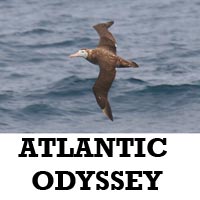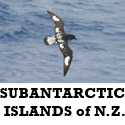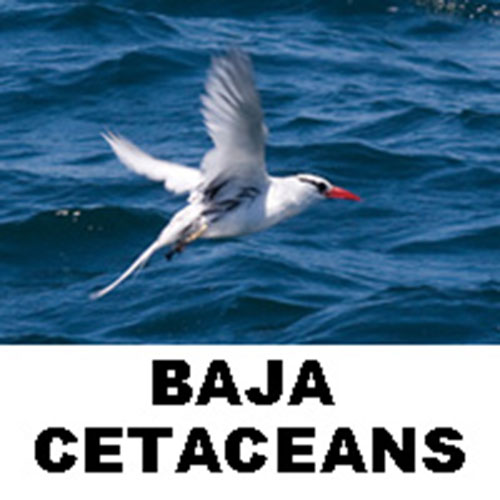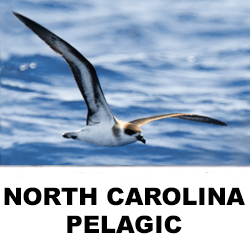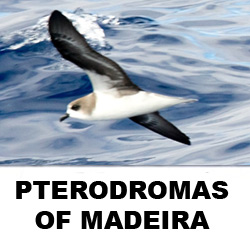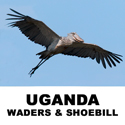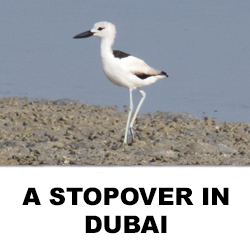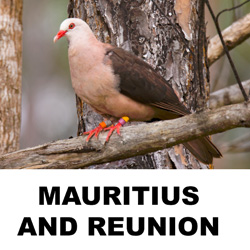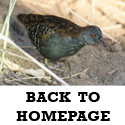|
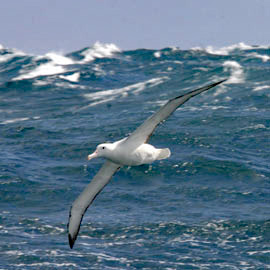 The voyage to the Subantarctic Islands of New Zealand and Australia, run by Heritage Expeditions, is basically the
only way to access that area of the Southern Oceans. Various trips are run, but a serious birder would probably only be
interested in this one or one also going down to the Antarctic Continent, which is even more expensive. The voyage we undertook
visited the Snares, Auckland, and Macquarie Islands, and returned to New Zealand by way of the Bounties, Antipodes and
Chathams. If contemplating such a journey, bear in mind that weather conditions can be really bad (they weren't too wonderful
on our trip), and it may not be possible to visit all the islands. Landing is not allowed on several groups, but this is not
important, since the Zodiac crews are very experienced and birds, especially penguins, can be approached very closely.
Where this is not the case, such as Pyramid Rock, breeding site of Chatham Albatross, chumming brings the birds equally close
at the back of the ship.
The voyage to the Subantarctic Islands of New Zealand and Australia, run by Heritage Expeditions, is basically the
only way to access that area of the Southern Oceans. Various trips are run, but a serious birder would probably only be
interested in this one or one also going down to the Antarctic Continent, which is even more expensive. The voyage we undertook
visited the Snares, Auckland, and Macquarie Islands, and returned to New Zealand by way of the Bounties, Antipodes and
Chathams. If contemplating such a journey, bear in mind that weather conditions can be really bad (they weren't too wonderful
on our trip), and it may not be possible to visit all the islands. Landing is not allowed on several groups, but this is not
important, since the Zodiac crews are very experienced and birds, especially penguins, can be approached very closely.
Where this is not the case, such as Pyramid Rock, breeding site of Chatham Albatross, chumming brings the birds equally close
at the back of the ship.
Our voyage began at the port of Bluff, at the southernmost tip of South Island. Many people take the opportunity to do some
birding in New Zealand before or after the trip, so no land-based birding is organised for the group as a whole. Our voyage
began in the early afternoon (departure varies according to tides and conditions) in a fairly calm sea. This enabled views
of Little Blue and, more importantly, Fiordland Crested Penguins. At this
time of year this species is largely away from its breeding areas and can be difficult to connect with. Another species seen,
in good numbers, on our first afternoon was Mottled Petrel, which breeds on Stewart Island. Five
Cook's Petrels were also seen, the only ones of the trip.
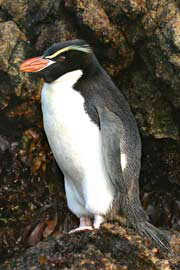 Other birds, most of which were to feature fairly regularly throughout the trip included Black-browed,
White-capped and Salvin's Albatrosses, Northern Giant Petrels, Cape Petrels, Black-bellied
Storm-petrels, Common Diving-petrels and a single White-chinned Petrel. The Diving-petrels
may well have included one or more South Georgia Diving-petrels from the breeding outpost on Codfish Island (off Stewart Island),
but identification at the range we saw them is all but impossible.
The ship sailed down the east coast of Stewart Island and we spent the evening in a sheltered bay off Port Pegasus. At 6.00am
the next morning we were a couple of miles off Snares island, having sailed overnight. An early Zodiac cruise was laid on, those
on the first cruise had breakfast on their return, the second group had breakfast and then did their cruise when the three
Zodiacs had returned with the first group. This worked well,
nobody missed anything since only three species were seen, Fernbird,
Tomtit (of the all black form), and of course thousands of Snares crested Penguins. The
Zodiacs were able to approach to a few metres in Boat Harbour Bay, although the actual penguin colonies are invisible in
the bush plenty of birds were coming and going and in the water. The bush in most places comes right down to the shore, this also
enabled good views of the two passerines. Leaving the bay we went to have a look at the "Penguin Ladder" an area of bare
granite by which the birds access nests higher up on the island, this was quite spectacular. Also around the area were
seen Antarctic Terns, NZ Fur seals and Hooker's Sealions.
Other birds, most of which were to feature fairly regularly throughout the trip included Black-browed,
White-capped and Salvin's Albatrosses, Northern Giant Petrels, Cape Petrels, Black-bellied
Storm-petrels, Common Diving-petrels and a single White-chinned Petrel. The Diving-petrels
may well have included one or more South Georgia Diving-petrels from the breeding outpost on Codfish Island (off Stewart Island),
but identification at the range we saw them is all but impossible.
The ship sailed down the east coast of Stewart Island and we spent the evening in a sheltered bay off Port Pegasus. At 6.00am
the next morning we were a couple of miles off Snares island, having sailed overnight. An early Zodiac cruise was laid on, those
on the first cruise had breakfast on their return, the second group had breakfast and then did their cruise when the three
Zodiacs had returned with the first group. This worked well,
nobody missed anything since only three species were seen, Fernbird,
Tomtit (of the all black form), and of course thousands of Snares crested Penguins. The
Zodiacs were able to approach to a few metres in Boat Harbour Bay, although the actual penguin colonies are invisible in
the bush plenty of birds were coming and going and in the water. The bush in most places comes right down to the shore, this also
enabled good views of the two passerines. Leaving the bay we went to have a look at the "Penguin Ladder" an area of bare
granite by which the birds access nests higher up on the island, this was quite spectacular. Also around the area were
seen Antarctic Terns, NZ Fur seals and Hooker's Sealions.
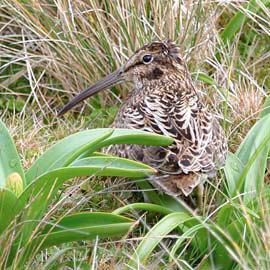 We set sail for the Auckland Islands just after midday, but as we continued south things got a little rough, and we weren't
watching for much of the time, however nothing was likely which we needed personally. Birds seen were similar to the previous
day, but the windy conditions also brought large flocks of Fairy Prions, among which a few
Antarctic Prions were identified. White-chinned Petrels and Sooty Shearwaters
were present in large numbers, and two Buller's and two Southern
Royal Albatrosses were seen. Brown Skuas began to appear in numbers, and a
South Polar Skua was identified among them.
We set sail for the Auckland Islands just after midday, but as we continued south things got a little rough, and we weren't
watching for much of the time, however nothing was likely which we needed personally. Birds seen were similar to the previous
day, but the windy conditions also brought large flocks of Fairy Prions, among which a few
Antarctic Prions were identified. White-chinned Petrels and Sooty Shearwaters
were present in large numbers, and two Buller's and two Southern
Royal Albatrosses were seen. Brown Skuas began to appear in numbers, and a
South Polar Skua was identified among them.
Arriving at the Auckland Island group in the late afternoon, the weather was still poor, but a sheltered anchorage was found
for the night, and in the morning we landed on Enderby Island, where we spent the day. The island has a path right around the
edge, boardwalked in places. Low bush occurs in the centre, and many species occur throughout the island, ranging from the
local race of Australian Pipit, which is so different it must be a potential split, to nesting
Southern Royal Albatross (a few pairs). There are several specialities which begin with Auckland Island Teal,
usually in the kelp beds at the landing site. The next "endemic" is Subantarctic Snipe,
which only occurs on islands in this region. Several birds were flushed but we were quite rightly not allowed to repeat the
exercise. However it proved possible, after most people had moved on, to stalk one or two birds and obtain good views and
photographs on the ground. The other bird which is endemic to the Auckland Islands, is the Auckland Shag.
Several groups of these were around the coastline, whilst further inland the endemic race of Banded
Dotterel (exilis) ran around our feet. Two further species, high on most birder's wants list, were seen, these being
Light-mantled Sooty Albatross on the cliff edge, and several Yellow-eyed Penguins
around the coastline, including an immature bird which was a "plumage tick" for us. There were several other species
including Red-crowned Parakeet, the Auckland island race of Tomtit
and New Zealand Falcon (not seen by everybody), but most were birds readily seen elsewhere.
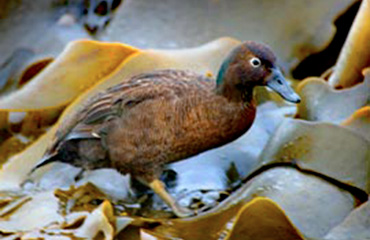 Despite much of the next day spent trying to make other landings in the Auckland Islands, the westerley gale continued and
put paid to our efforts. This did not cause us to miss any species, but it would have been nice to visit the Shy Albatross
colony on SW Cape, where birds can be approached quite closely. Talking of distance, most trips of this kind adhere to a
code of conduct which does not allow approach to within five metres, although this is absolutely fine it is often difficult
to observe, since many species will come to you out of curiosity, penguins especially. Albatrosses seem totally tolerant in
most circumstances, although I have been in an unavoidable situation, walking along a path between juveniles, where they became
a little agitated and clapped their bills at us as a warning. Normally anyone approaching that closely should be censured as
it is totally unnecessary, unfortunately not all eco-tourists put the wildlife first.
Despite much of the next day spent trying to make other landings in the Auckland Islands, the westerley gale continued and
put paid to our efforts. This did not cause us to miss any species, but it would have been nice to visit the Shy Albatross
colony on SW Cape, where birds can be approached quite closely. Talking of distance, most trips of this kind adhere to a
code of conduct which does not allow approach to within five metres, although this is absolutely fine it is often difficult
to observe, since many species will come to you out of curiosity, penguins especially. Albatrosses seem totally tolerant in
most circumstances, although I have been in an unavoidable situation, walking along a path between juveniles, where they became
a little agitated and clapped their bills at us as a warning. Normally anyone approaching that closely should be censured as
it is totally unnecessary, unfortunately not all eco-tourists put the wildlife first.
Mid-afternoon we gave up trying to land, and with a warning of what lay ahead storm-wise headed for Macquarie, expecting a
two-day steam. Indeed, although the storm abated somewhat overnight, many people were confined to cabins that afternoon and
all the following day. Those that did brave the conditions were rewarded with a number of new seabirds for the trip, although
all were seen in reasonable numbers subsequently. Increased numbers of albatrosses included Grey-headed,
Light-mantled Sooty, and our first fully identified Campbell Albatross. Later analysis of photos
showed that many of the birds previously identified as Black-browed were this species, since the only totally diagnostic
feature at sea is the eye-colour. Three new petrels appeared, the immaculate White-headed,
Soft-plumaged, and Blue, jinking and weaving in the wind. Blue petrels
are often in mixed flocks with prions, but are easily picked out by their white tail-tips. A Grey-backed
Storm-petrel was also seen, rather further north than expected. Some people saw three distant Orcas,
these are more often seen in waters around Macquarie.
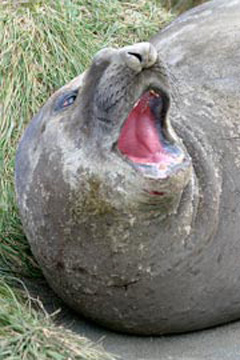 Fortunately, the storm continued to abate, we made up time, and the following morning saw us anchored off Macquarie Island.
However, the aftermath left the sea still too rough to allow a landing until early afternoon. Macquarie is an Australian
island, and we spent some time wondering about our reception from the research workers, since England had beaten Australia
in the Rugby World Cup three days previously. "No worries", everybody was really friendly and helpful, and afternoon tea
served at the base was superb! Our walk to this feast from the landing site took us through, or rather round (they just stand
and expect you to move!) King Penguins, Gentoos, and several Elephant seals.
Most of the latter were immature, still enormous but thankfully not aggressive, as they just lay over the base area anywhere
they please. After the refreshments some of the group found a couple of Southern Rockhopper Penguins
on the other side of the base, which were to be our only good views of this species.
Numbers of Macquarie Island Shags were around, whether these are
a good species or a race of Blue-eyed Shag I leave to the taxonomists, but they're still worth seeing.
The following day the weather had improved, and continued to do so, enabling us to land at Sandy Bay just after lunch. This
bay has a boardwalk which leads up to a colony containing thousands of Royal Penguins, endemic to
Macquarie. There was talk of there being a Macaroni Penguin among them, but nobody managed to pick it out,
which was not surprising given the similarity of the two and the variation in facial colour of Royal Penguins.
At the other end of the bay is a large King Penguin colony. Diversions in between included Elephant Seal pups
which would come and nuzzle your legs, or investigate rucksacks, and constant groups of penguins leaving the water and making
their way to their nests. Also of interest were both Northern and Southern Giant Petrels,
including white phase birds. I actually photographed birds of both species sitting next to each other on the beach, giving an ideal
opportunity to compare the bill-tip colours, which is a diagnostic feature separating them.Due to everything going on around, I never did
get to the breeding King Penguins, having to be dragged back to the zodiac for return to the ship.
Fortunately, the storm continued to abate, we made up time, and the following morning saw us anchored off Macquarie Island.
However, the aftermath left the sea still too rough to allow a landing until early afternoon. Macquarie is an Australian
island, and we spent some time wondering about our reception from the research workers, since England had beaten Australia
in the Rugby World Cup three days previously. "No worries", everybody was really friendly and helpful, and afternoon tea
served at the base was superb! Our walk to this feast from the landing site took us through, or rather round (they just stand
and expect you to move!) King Penguins, Gentoos, and several Elephant seals.
Most of the latter were immature, still enormous but thankfully not aggressive, as they just lay over the base area anywhere
they please. After the refreshments some of the group found a couple of Southern Rockhopper Penguins
on the other side of the base, which were to be our only good views of this species.
Numbers of Macquarie Island Shags were around, whether these are
a good species or a race of Blue-eyed Shag I leave to the taxonomists, but they're still worth seeing.
The following day the weather had improved, and continued to do so, enabling us to land at Sandy Bay just after lunch. This
bay has a boardwalk which leads up to a colony containing thousands of Royal Penguins, endemic to
Macquarie. There was talk of there being a Macaroni Penguin among them, but nobody managed to pick it out,
which was not surprising given the similarity of the two and the variation in facial colour of Royal Penguins.
At the other end of the bay is a large King Penguin colony. Diversions in between included Elephant Seal pups
which would come and nuzzle your legs, or investigate rucksacks, and constant groups of penguins leaving the water and making
their way to their nests. Also of interest were both Northern and Southern Giant Petrels,
including white phase birds. I actually photographed birds of both species sitting next to each other on the beach, giving an ideal
opportunity to compare the bill-tip colours, which is a diagnostic feature separating them.Due to everything going on around, I never did
get to the breeding King Penguins, having to be dragged back to the zodiac for return to the ship.
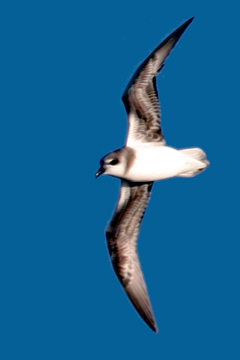 Our next destination was Campbell Island, we left Macquarie late afternoon and spent the next day at sea. Conditions were
variable but predominantly from behind the ship which helped greatly to calm the ship's movement whilst providing plenty of
seabirds to watch. Several other species breed on Macquarie but are nocturnal at their colonies so far easier to see at sea.
Albatrosses, Petrels and Prions were again the main fare, the only new record for the trip was our first
Wilson's Storm-petrel. We reached our destination in the early hours of the following day, and the weather deteriorated
in time to welcome us! Being in a sheltered harbour we were still able to land, and much of our route was traversed by a
boardwalk, but an almost gale force wind, rain and sleet put many people off initially, and some returned when half-way up the Col.
However, we elected to wait and watch Light-mantled Sooties and Campbell Island Shags in the bay,
and conditions did improve after an hour or so, and it seemed they were to continue improving, so the majority of those still on
the ship left for the island.
Our next destination was Campbell Island, we left Macquarie late afternoon and spent the next day at sea. Conditions were
variable but predominantly from behind the ship which helped greatly to calm the ship's movement whilst providing plenty of
seabirds to watch. Several other species breed on Macquarie but are nocturnal at their colonies so far easier to see at sea.
Albatrosses, Petrels and Prions were again the main fare, the only new record for the trip was our first
Wilson's Storm-petrel. We reached our destination in the early hours of the following day, and the weather deteriorated
in time to welcome us! Being in a sheltered harbour we were still able to land, and much of our route was traversed by a
boardwalk, but an almost gale force wind, rain and sleet put many people off initially, and some returned when half-way up the Col.
However, we elected to wait and watch Light-mantled Sooties and Campbell Island Shags in the bay,
and conditions did improve after an hour or so, and it seemed they were to continue improving, so the majority of those still on
the ship left for the island.
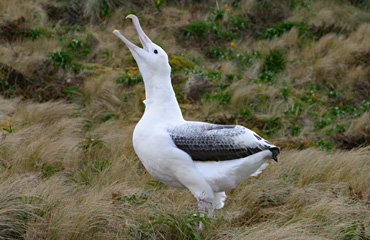 The walk up Col Lyall was still strenuous due to the wind, but well worth it as the top has a Southern Royal Albatross colony,
and the view is superb. In the afternoon birds were quite active, sky-calling, mutual preening, and generally coming and going.
Being close to one of the largest birds in the world, on the ground, is an unforgettable experience. Few other birds were seen,
Red-billed and Kelp Gulls, Antarctic Terns and a number of Campbell Island Shags. A few introduced passerines occur including
Silvereye, Dunnock and Redpoll, also native Australian Pipits, again looking very different to their mainland conterparts.
One Elephant seal was around and several Hooker's Sea-lions, one young male providing (too) close views as it seemed to want
to prevent us returning to the ship! Happily no-one was actually attacked.
The following day was spent at sea heading for Antipodes Island, the wind again from behind so plenty of seawatching.
early the following morning we awoke to flocks of Subantarctic Little Shearwaters, our first for the trip. Following the latest suggested taxonomy we could have seen Little Shearwater, another species, near the end of the voyage, unfortunately we were probably a bit far south.
Good numbers of birds we had seen before was the order of the day, although a few new birds appeared in the shape of Broad-billed Prion and Grey-faced Petrel. Several Wandering Albatrosses were seen, depending
on your taxonomic viewpoint Snowy Albatross, as distinct from Gibson's, was potentially new. A few
people saw a couple of Erect-crested Penguins in the water, but most were happy to see them the next day from the Zodiac
cruise.
No landings are pemitted on Antipodes Island, but once again Zodiacs take you in among the kelp and close to the main
speciality, thousands of Erect-crested Penguins. There is also an endemic landbird,
Antipodes Parakeet, but although Red-crowned Parakeets were plentiful, only about half the birders
were able to connect with this all-green bird which is very similar in size and jizz. In the afternoon a chumming session was attempted, using cut-up fish. This was reasonably succesful in terms of bringing some birds close, but nothing new was observed.
However it did serve to convince some sceptics of the worth of such an exercise and was therefore repeated later with much
more spectacular results. That evening the ship steamed for the Bounty Islands, another group on which no landing is allowed.
In the event the weather, which had deteriorated slightly, did not allow Zodiac cruising, but we spent three hours circling
the islands in the "mother ship" and did some more chumming. Many seabirds breed on the Bounties, some 20 knobs of granite
in the ocean, and good, close views were obtained of several, from Albatrosses to Prions, large numbers of Salvin's Albatross
were a feature. New species were Bounty Island Shag, numbers of
which flew close to the ship, and Fulmar Prion, which is almost impossible to distinguish from
Fairy Prion, a much more widespread species. However, they have different breeding strategies, Fulmars nest in rock scree as
opposed to burrows, and we were actually able to see them fly to scree areas which helped confirm our identification.
Another new species, which came to the chum, was Grey Petrel, this was a lucky sighting as the
majority of birds, winter breeders, have left the area at the time in question.
The walk up Col Lyall was still strenuous due to the wind, but well worth it as the top has a Southern Royal Albatross colony,
and the view is superb. In the afternoon birds were quite active, sky-calling, mutual preening, and generally coming and going.
Being close to one of the largest birds in the world, on the ground, is an unforgettable experience. Few other birds were seen,
Red-billed and Kelp Gulls, Antarctic Terns and a number of Campbell Island Shags. A few introduced passerines occur including
Silvereye, Dunnock and Redpoll, also native Australian Pipits, again looking very different to their mainland conterparts.
One Elephant seal was around and several Hooker's Sea-lions, one young male providing (too) close views as it seemed to want
to prevent us returning to the ship! Happily no-one was actually attacked.
The following day was spent at sea heading for Antipodes Island, the wind again from behind so plenty of seawatching.
early the following morning we awoke to flocks of Subantarctic Little Shearwaters, our first for the trip. Following the latest suggested taxonomy we could have seen Little Shearwater, another species, near the end of the voyage, unfortunately we were probably a bit far south.
Good numbers of birds we had seen before was the order of the day, although a few new birds appeared in the shape of Broad-billed Prion and Grey-faced Petrel. Several Wandering Albatrosses were seen, depending
on your taxonomic viewpoint Snowy Albatross, as distinct from Gibson's, was potentially new. A few
people saw a couple of Erect-crested Penguins in the water, but most were happy to see them the next day from the Zodiac
cruise.
No landings are pemitted on Antipodes Island, but once again Zodiacs take you in among the kelp and close to the main
speciality, thousands of Erect-crested Penguins. There is also an endemic landbird,
Antipodes Parakeet, but although Red-crowned Parakeets were plentiful, only about half the birders
were able to connect with this all-green bird which is very similar in size and jizz. In the afternoon a chumming session was attempted, using cut-up fish. This was reasonably succesful in terms of bringing some birds close, but nothing new was observed.
However it did serve to convince some sceptics of the worth of such an exercise and was therefore repeated later with much
more spectacular results. That evening the ship steamed for the Bounty Islands, another group on which no landing is allowed.
In the event the weather, which had deteriorated slightly, did not allow Zodiac cruising, but we spent three hours circling
the islands in the "mother ship" and did some more chumming. Many seabirds breed on the Bounties, some 20 knobs of granite
in the ocean, and good, close views were obtained of several, from Albatrosses to Prions, large numbers of Salvin's Albatross
were a feature. New species were Bounty Island Shag, numbers of
which flew close to the ship, and Fulmar Prion, which is almost impossible to distinguish from
Fairy Prion, a much more widespread species. However, they have different breeding strategies, Fulmars nest in rock scree as
opposed to burrows, and we were actually able to see them fly to scree areas which helped confirm our identification.
Another new species, which came to the chum, was Grey Petrel, this was a lucky sighting as the
majority of birds, winter breeders, have left the area at the time in question.
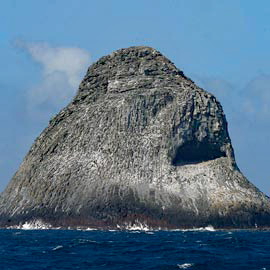
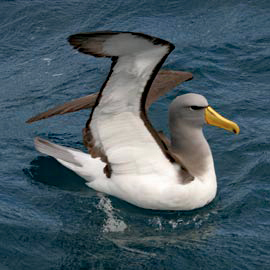 Our next port of call was the Chathams, the last group of islands to be visited. Spread over quite a large area
they encompass two sites of world importance, neither of which allow landing but can be very successfully visited. The
first of these is little more than a large triangular rock, known as Pyramid Rock. This is the only breeding station of
Chatham Albatross, some 3000 pairs of which cover the surface with their nests. However many other
species breed in these waters, on the Bounties and the Chathams, so again seawatching was excellent. Little was new until
we approached the Rock, although good numbers of Grey-faced Petrels were seen for the first time. As from yesterday we had
stood a chance of the BIG ONE, Magenta Petrel, but we were not to be lucky this time. This species, only about 30 pairs
of which exist, has only been seen twice on these voyages since they started, and then only by more than a couple of
birders on one occasion. The other rarity, Chatham Island Petrel, usually is seen, but we unfortunately dipped on that
also. Have to go again!
On arriving at Pyramid Rock in the afternoon the ship circumnavigated it and everyone had great views of Chatham Albatrosses.
Taxonomic debate is rife as to whether this is a good species, but with its dark grey head and neck contrasting with a bright
yellow bill it's good enough for us! More importantly, adults in particular are rarely seen away from the breeding area
whereas other members of the group (Shy, Salvin's) occur over a vast area of ocean.
Sailing away from the island in the late afternoon we had another chumming session
which proved to be one of the highlights of the trip. Up to two hundred albatrosses, of no less than ten species, came to
investigate, so close that converters were removed from lenses and a 200mm lens was fine on occasion. A highlight of the
highlight was an Indian Yellow-nosed Albatross which flew down one side of the ship about 20 metres off before deciding
it didn't fancy the competition at the chum! This bird has been present in the colony for a few years, indeed some attempt
had been made to scope the colony but in 5000 birds it proved impossible to locate. It also illustrates why on these trips
careful planning as to where you are on the ship at particular times is paramount. Only shower after dark!
Although one had been seen on the previous day it was only now that Northern Royal Albatross
was seen well and in reasonable numbers, and several Buller's gave us our first close views. Many of this last species
began to follow the ship as it headed onward, and one or two still followed the following day. Few other species came
to the chum, White-chinned Petrels and Sooty Shearwaters in the main, but others were seen throughout the day, all but one of
which had been seen previously. The addition to the list was White-faced Storm-petrel, which
breeds in small numbers on many islands in New Zealand waters.
Our next port of call was the Chathams, the last group of islands to be visited. Spread over quite a large area
they encompass two sites of world importance, neither of which allow landing but can be very successfully visited. The
first of these is little more than a large triangular rock, known as Pyramid Rock. This is the only breeding station of
Chatham Albatross, some 3000 pairs of which cover the surface with their nests. However many other
species breed in these waters, on the Bounties and the Chathams, so again seawatching was excellent. Little was new until
we approached the Rock, although good numbers of Grey-faced Petrels were seen for the first time. As from yesterday we had
stood a chance of the BIG ONE, Magenta Petrel, but we were not to be lucky this time. This species, only about 30 pairs
of which exist, has only been seen twice on these voyages since they started, and then only by more than a couple of
birders on one occasion. The other rarity, Chatham Island Petrel, usually is seen, but we unfortunately dipped on that
also. Have to go again!
On arriving at Pyramid Rock in the afternoon the ship circumnavigated it and everyone had great views of Chatham Albatrosses.
Taxonomic debate is rife as to whether this is a good species, but with its dark grey head and neck contrasting with a bright
yellow bill it's good enough for us! More importantly, adults in particular are rarely seen away from the breeding area
whereas other members of the group (Shy, Salvin's) occur over a vast area of ocean.
Sailing away from the island in the late afternoon we had another chumming session
which proved to be one of the highlights of the trip. Up to two hundred albatrosses, of no less than ten species, came to
investigate, so close that converters were removed from lenses and a 200mm lens was fine on occasion. A highlight of the
highlight was an Indian Yellow-nosed Albatross which flew down one side of the ship about 20 metres off before deciding
it didn't fancy the competition at the chum! This bird has been present in the colony for a few years, indeed some attempt
had been made to scope the colony but in 5000 birds it proved impossible to locate. It also illustrates why on these trips
careful planning as to where you are on the ship at particular times is paramount. Only shower after dark!
Although one had been seen on the previous day it was only now that Northern Royal Albatross
was seen well and in reasonable numbers, and several Buller's gave us our first close views. Many of this last species
began to follow the ship as it headed onward, and one or two still followed the following day. Few other species came
to the chum, White-chinned Petrels and Sooty Shearwaters in the main, but others were seen throughout the day, all but one of
which had been seen previously. The addition to the list was White-faced Storm-petrel, which
breeds in small numbers on many islands in New Zealand waters.
 From Pyramid Rock we made our way to Rangatira (South East) Island, in order to zodiac cruise the following morning.
Landing is not allowed on this uninhabited island, as it is so important from a conservation viewpoint. Our first avian
encounter was with a colony of Pitt Island Shags. Some birders had seen this recent split from Spotted Shag
the previous day, but much better views were now enjoyed by everyone. In the same area were a few Little Blue Penguins of the
race chathamensis. Next came another of the trips highlights, not a seabird this time but a wader, in the shape of
Shore Plover. This bird is found nowhere else in the world, except for a few areas where attempts
have been made at re-introduction. The scheme is not progressing terribly well, one problem being that early attempts were
negated by birds flying back to their natal island, Rangatira! If you are a purist (or have seen birds on Rangatira)
the others aren't yet tickable!
However, I think most birders are quite happy to see birds on their "new" islands, but even that is not easy. We saw birds on Motorua,
but the re-introduction scheme there was thwarted by Morepork. A predator-free island was chosen, but "predator-free" also means less prey
species for the owls, and the owls could not be translocated due to their significance to local Maoris. The second island was private and
not accesible at all, at the time of this update (2019) birds exist on several offshore islets but none is easily reached. Due to the
re-introduction scheme birds are occasionally seen on the mainland since they will move up to 200km, but the only reliable "stake-out" is a
Zodiac close inshore to Rangatira.
Several Shore Plovers were seen on wave platforms, and although the seas prevented a really close approach, good views were
had by all, and acceptable photos. Not so the other wader here, if anything more endangered, although less well-known, that being the
Chatham Island Oystercatcher. We thought we were going to dip until I caught sight of one disappearing over a tussock, and
on moving into the next bay everyone eventually connected with a couple. They also occur on the main Chatham Island, so
all may not have been lost, but we failed to find any more. Several other landbirds were seen from the Zodiac, Chatham
races of Tomtit, Tui, Pipit and Red-crowned Parakeet. None of these is a potential split, but who knows in the future?
Seabirds were not completely forgotten today, as well as the usual species at sea, a few Chatham Island
Shags were seen, albeit not terribly well.
From Pyramid Rock we made our way to Rangatira (South East) Island, in order to zodiac cruise the following morning.
Landing is not allowed on this uninhabited island, as it is so important from a conservation viewpoint. Our first avian
encounter was with a colony of Pitt Island Shags. Some birders had seen this recent split from Spotted Shag
the previous day, but much better views were now enjoyed by everyone. In the same area were a few Little Blue Penguins of the
race chathamensis. Next came another of the trips highlights, not a seabird this time but a wader, in the shape of
Shore Plover. This bird is found nowhere else in the world, except for a few areas where attempts
have been made at re-introduction. The scheme is not progressing terribly well, one problem being that early attempts were
negated by birds flying back to their natal island, Rangatira! If you are a purist (or have seen birds on Rangatira)
the others aren't yet tickable!
However, I think most birders are quite happy to see birds on their "new" islands, but even that is not easy. We saw birds on Motorua,
but the re-introduction scheme there was thwarted by Morepork. A predator-free island was chosen, but "predator-free" also means less prey
species for the owls, and the owls could not be translocated due to their significance to local Maoris. The second island was private and
not accesible at all, at the time of this update (2019) birds exist on several offshore islets but none is easily reached. Due to the
re-introduction scheme birds are occasionally seen on the mainland since they will move up to 200km, but the only reliable "stake-out" is a
Zodiac close inshore to Rangatira.
Several Shore Plovers were seen on wave platforms, and although the seas prevented a really close approach, good views were
had by all, and acceptable photos. Not so the other wader here, if anything more endangered, although less well-known, that being the
Chatham Island Oystercatcher. We thought we were going to dip until I caught sight of one disappearing over a tussock, and
on moving into the next bay everyone eventually connected with a couple. They also occur on the main Chatham Island, so
all may not have been lost, but we failed to find any more. Several other landbirds were seen from the Zodiac, Chatham
races of Tomtit, Tui, Pipit and Red-crowned Parakeet. None of these is a potential split, but who knows in the future?
Seabirds were not completely forgotten today, as well as the usual species at sea, a few Chatham Island
Shags were seen, albeit not terribly well.
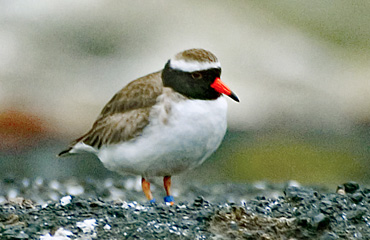 Most of us stayed on deck till dark, since there was a chance of Magenta Petrel, but alas in vain.
The following morning saw the ship anchored at the main Chatham Island, having moved overnight. Chatham Shags were around
the harbour, giving much better views than the previous day, but sadly no Oystercatchers. Indeed, our visit ashore was a
bit of an anti-climax, since there are relatively few landbirds and we obviously couldn't go anywhere near the seabird colonies. What landbirds there were consisted of European introductions, an endemic race of (Grey) Fantail, and the
endemic Chatham Island Gerygone and Chatham Island Pigeon, (split from New Zealand Pigeon by some authorities). Some people saw Weka, which although a native species is a threat to any ground-nesting species. A few Spur-winged Plovers and Australasian Harriers were also in evidence.
We left the Chathams after lunch and, after a last chumming session late afternoon, which produced good views but nothing new, headed for the mainland of New Zealand.
Most of us stayed on deck till dark, since there was a chance of Magenta Petrel, but alas in vain.
The following morning saw the ship anchored at the main Chatham Island, having moved overnight. Chatham Shags were around
the harbour, giving much better views than the previous day, but sadly no Oystercatchers. Indeed, our visit ashore was a
bit of an anti-climax, since there are relatively few landbirds and we obviously couldn't go anywhere near the seabird colonies. What landbirds there were consisted of European introductions, an endemic race of (Grey) Fantail, and the
endemic Chatham Island Gerygone and Chatham Island Pigeon, (split from New Zealand Pigeon by some authorities). Some people saw Weka, which although a native species is a threat to any ground-nesting species. A few Spur-winged Plovers and Australasian Harriers were also in evidence.
We left the Chathams after lunch and, after a last chumming session late afternoon, which produced good views but nothing new, headed for the mainland of New Zealand.
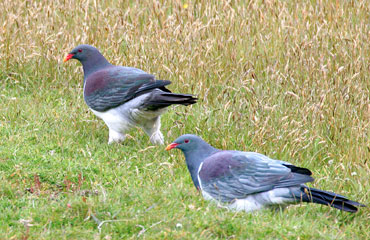 We now had the prospect of two days at sea crossing the Chatham Rise, which should have been good for not only seabirds
but cetaceans also. Unfortunately the weather was yet again unkind on the first day and no cetaceans were seen.
The birds however were obviously in the air, especially Albatrosses and Pterodromas, although numbers of observers were a
bit down. Cook's Petrels re-appeared, having not been seen since the early part of the trip, but not a sniff of Chatham
Island Petrel nor Black-winged, which we rather expected (they breed on Chatham). The weather calmed markedly on the second
day and we became resigned to the fact this just wasn't to be a good cetacean trip, a few Dusky Dolphins
were seen but that was about all before lunch. However, on our last afternoon at sea came the sting in the tail, a
Grey's Beaked Whale, seen briefly but close enough to get a photo of the "beak", which aided the identification process.
Having positively identified the animal, it was revealed that the same trip had recorded the same species two years previously
on the same date and within 30 minutes of the same time! Checking the ship's log for that sighting suggested that the two
records were within 15 miles of each other- perhaps this will become one of the world's first cetacean stake-outs!
The remainder of our trip was uneventful, and we arrived back at Otago Harbour early the following morning, whence we went
our separate ways, in our case to attempt better views of Black Stilt than we had enjoyed on a previous visit to New Zealand
(Yes-we did).
We now had the prospect of two days at sea crossing the Chatham Rise, which should have been good for not only seabirds
but cetaceans also. Unfortunately the weather was yet again unkind on the first day and no cetaceans were seen.
The birds however were obviously in the air, especially Albatrosses and Pterodromas, although numbers of observers were a
bit down. Cook's Petrels re-appeared, having not been seen since the early part of the trip, but not a sniff of Chatham
Island Petrel nor Black-winged, which we rather expected (they breed on Chatham). The weather calmed markedly on the second
day and we became resigned to the fact this just wasn't to be a good cetacean trip, a few Dusky Dolphins
were seen but that was about all before lunch. However, on our last afternoon at sea came the sting in the tail, a
Grey's Beaked Whale, seen briefly but close enough to get a photo of the "beak", which aided the identification process.
Having positively identified the animal, it was revealed that the same trip had recorded the same species two years previously
on the same date and within 30 minutes of the same time! Checking the ship's log for that sighting suggested that the two
records were within 15 miles of each other- perhaps this will become one of the world's first cetacean stake-outs!
The remainder of our trip was uneventful, and we arrived back at Otago Harbour early the following morning, whence we went
our separate ways, in our case to attempt better views of Black Stilt than we had enjoyed on a previous visit to New Zealand
(Yes-we did).
|










